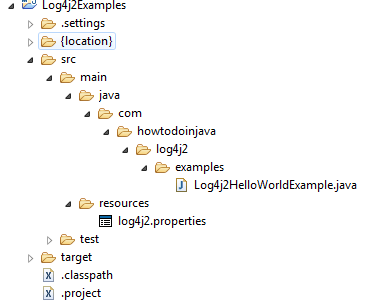Learn to configure log4j2.properties file to output the log statements to the console, rolling files, etc. Learn to configure log4j2 appenders, levels, and patterns.
1. Log4j2 Dependencies
Please note that using Log4j2 with SLF4J is the recommended approach.
1.1. Maven
To include Log4j2, include the latest version of log4j-core and log4j-api dependencies.
<dependency>
<groupId>org.apache.logging.log4j</groupId>
<artifactId>log4j-api</artifactId>
<version>2.31.1</version>
</dependency>
<dependency>
<groupId>org.apache.logging.log4j</groupId>
<artifactId>log4j-core</artifactId>
<version>2.31.1</version>
</dependency>1.2. Gradle
dependencies {
implementation 'org.apache.logging.log4j:log4j-api:2.19.0'
implementation 'org.apache.logging.log4j:log4j-core:2.19.0'
}2. The Default Logging Behavior
The default behavior kicks in when:
- there is no
log4j.configurationFileproperty is present in the startup arguments or when this property doesn’t point to a valid configuration file. - there is no valid log4j2-test.[xml|properties|yaml|json] file present in the classpath.
- there is no log4j2.[xml|properties|yaml|json] file present in the classpath.
By default, Log4j2 will use the ConsoleAppender to write the log message to the console.
Also, the root logger is default and defined with the ERROR level. This means that only ERROR log statements will be visible and INFO, DEBUG, and TRACE level messages will not be visible.
3. Configuring log4j2.properties for Console Logging
We can use the below log4j2.properties file logging output into the console. If no configuration file can be located, DefaultConfiguration will be used, which also logs on to the console.
# Set to debug or trace if log4j initialization is failing
status = warn
# Root logger level
rootLogger.level = debug
# Console appender configuration
appender.console.type = Console
appender.console.name = consoleLogger
appender.console.layout.type = PatternLayout
appender.console.layout.pattern = %d{yyyy-MM-dd HH:mm:ss} %-5p %c{1}:%L - %m%n
# Root logger referring to console appender
rootLogger.appenderRef.stdout.ref = consoleLogger4. Configuring log4j2.properties for Rolling Files
We can use the below log4j2.properties file logging output with time and size-based rolling files.
status = warn
name= RollingFileLogConfigDemo
# Log files location
property.basePath = c:/temp/logs
# RollingFileAppender name, pattern, path and rollover policy
appender.rolling.type = RollingFile
appender.rolling.name = fileLogger
appender.rolling.fileName= ${basePath}/app.log
appender.rolling.filePattern= ${basePath}/app_%d{yyyy-MM-dd}-%i.log.gz
appender.rolling.layout.type = PatternLayout
appender.rolling.layout.pattern = %d{yyyy-MM-dd HH:mm:ss.SSS} %level [%t] [%l] - %msg%n
appender.rolling.policies.type = Policies
# RollingFileAppender rotation policy
appender.rolling.policies.size.type = SizeBasedTriggeringPolicy
appender.rolling.policies.size.size = 10MB
appender.rolling.policies.time.type = TimeBasedTriggeringPolicy
appender.rolling.policies.time.interval = 1
appender.rolling.policies.time.modulate = true
appender.rolling.strategy.type = DefaultRolloverStrategy
appender.rolling.strategy.delete.type = Delete
appender.rolling.strategy.delete.basePath = ${basePath}
appender.rolling.strategy.delete.maxDepth = 10
appender.rolling.strategy.delete.ifLastModified.type = IfLastModified
# Delete all files older than 30 days
appender.rolling.strategy.delete.ifLastModified.age = 30d
# Configure root logger
rootLogger.level = debug
rootLogger.appenderRef.rolling.ref = fileLogger5. Scanning log4j2.properties File in Classpath
We should put log4j2.properties anywhere in the application’s classpath. Log4j2 will scan all classpath locations to find out this file and then load it.
We have put the file in resources folder.

If we are using an external log4j2 configuration file, then we can provide the path of the configuration file using the application startup parameter or system property log4j2.configurationFile. Note that this property value is not restricted to a location on the local file system and may contain a URL.
-Dlog4j2.configurationFile=file:/home/lokesh/log4j2.propertiesA commonly seen approach is to set the log4j2.configurationFile property in the method annotated with @BeforeAll in the junit test class. This will allow an arbitrarily named file to be used during the test.
6. Demo
Let’s write a Java class and a few log statements to verify that logs are appearing in the console and log file.
In Log4j2, we use LogManager.getLogger() to get a Logger instance with a specific name or class.
import org.apache.logging.log4j.LogManager;
import org.apache.logging.log4j.Logger;
public class Main {
public static void main(final String[] args) {
private static final Logger logger = LogManager.getLogger(Main.class);
logger.debug("Debug Message Logged !!!");
logger.info("Info Message Logged !!!");
logger.error("Error Message Logged !!!", new NullPointerException("NullError"));
}
}When using Log4j2 with SLF4J, to log the statements, we get the Logger instance by using the SLF4J LoggerFactory class and its getLogger() method. Then we use various methods Logger to write the log records, such as info(), error() and debug().
import org.slf4j.Logger;
import org.slf4j.LoggerFactory;
public class Main {
public static void main(final String[] args) {
Logger logger = LoggerFactory.getLogger(Main.class);
logger.debug("Debug Message Logged !!!");
logger.info("Info Message Logged !!!");
logger.error("Error Message Logged !!!", new NullPointerException("NullError"));
}
}Now when you run the above program, we will get the below log statements in the console.
2021-12-14 14:26:32.737 DEBUG [main] [com.howtodoinjava.demo.slf4j.Main.main (Main.java:10)] - Debug Message Logged !!!
2021-12-14 14:26:32.739 INFO [main] [com.howtodoinjava.demo.slf4j.Main.main (Main.java:11)] - Info Message Logged !!!
2021-12-14 14:26:32.739 ERROR [main] [com.howtodoinjava.demo.slf4j.Main.main (Main.java:12)] - Error Message Logged !!!
java.lang.NullPointerException: NullError
at com.howtodoinjava.demo.slf4j.Main.main (Main.java:12) [classes/:?]
Happy Learning !!


Comments